.
Nunca é demais homenagear este "génio".
"Before he was secretly buried on a dark winter morning in a lonely Icelandic churchyard at the age of 64 . . . before his last ailing days of bad kidneys and rotting teeth . . . before the long hours whiled away at a Reykjavik bookstore, a place that vaguely reminded him of one from his Brooklyn youth . . . and before his decades of ghostly peregrinations through the world, like a profane monk or an idiot savant searching for perfect exile . . . before his bizarre eruptions . . . and before the spectacle of meeting his one-time nemesis, the former world-champion chess player Boris Spassky, for an anticlimactic 1992 rematch in war-torn Yugoslavia despite U.N. sanctions against it . . . even way back before their original 1972 meeting, called the Match of the Century, when the eyes of the world were riveted on him as a shining emblem of American will, innovation and brilliance . . . even before his brazen, almost obnoxious deconstruction of a cavalcade of grandmasters who stood in his path to Spassky . . . before he traded the rags of his youth for his new wardrobe of expensive suits . . . before his mind slowly unhinged and he became a walking paradox . . . yes, before the whole circus of his life unfolded, he was a 13-year-old kid in the first flush of the thing he most loved in the world: chess."
O autor deste texto, Michael Paterniti, continua a descrever o dia de Outubro de 1956, quando "o puto" Fischer "espetou uma carga de porrada" monumental ao ao mestre americano Donald Byrne.
Byrne,Donald - Fischer,Robert James [D97]
Rosenwald New York, 1956 (no final existe um link para o "replay" da mesma )
1.Nf3 Nf6 2.c4 g6 3.Nc3 Bg7 4.d4 0-0 5.Bf4.Byrne is avoiding the King's Indian (with 5.e4), probably because he had heard that the lad sitting across from him was already one of the best KI players in the country. 5...d5 6.Qb3 dxc4 7.Qxc4 c6 8.e4 Nbd7 9.Rd1 Nb6 10.Qc5 Bg4 11.Bg5?!
11...Na4!! Reuben Fine awards this move three exclamation points (in "The World's Great Chess Games") and calls it "a brilliant reply". Flohr and Botvinnik in "64" called it "a shocking and stunning move." Fred Reinfeld called it "one of the most magnificent moves ever made on a chessboard," and recently GM Jon Rowson referred to it as "one of the single most powerful chess moves of all time." 12.Qa3. This is forced, probably the only playable move in the position. [12.Nxa4 The knight sacrifice cannot be accepted: 12...Nxe4 13.Qc1 (13.Qxe7 Qa5+ 14.b4 Qxa4 15.Qxe4 Rfe8 16.Be7 Bxf3 17.gxf3 Bf8 and Black is winning) 13...Qa5+ 14.Nc3 Bxf3 15.gxf3 Nxg5 and Black is clearly better (Shipov)] 12...Nxc3. A kibitzing GM here said that Black was simply lost in this position. 13.bxc3 Nxe4! Fine and Reinfeld give two exclamation marks. 14.Bxe7 Qb6!
15.Bc4 Taking is not advisable: 15.Bxf8 Bxf8 16.Qb3 Nxc3! "and Black is clearly better here" (Gligoric). 15...Nxc3! "Black comes up with one beautiful move after another" (I. Chernev). 16.Bc5. 16.Qxc3 Rfe8 17.Bxf7+ Kxf7 18.Ng5+ Kxe7 (Interesting that 18...Kg8?? would have given the opponent a spectacular finish: 19.Qc4+ Be6 20.Qxe6+ Kh8 21.Nf7+ Kg8 22.Nh6+ Kh8 23.Qg8+ Rxg8 24.Nf7# A smothered mate for White!) 19.0-0 Bxd1 20.Rxd1 Qb5 and Black is winning. 16...Rfe8+ 17.Kf1.
17...Be6!! The move that brought the 13-year-old instant world-wide fame. Reuben Fine gave it four exclamation marks ("An astounding reply ... which wins in all variations"), Flohr gave it three. "To have foreseen this spectacular queen sacrifice several moves in advance – as Fischer must have done – is extraordinary"; writes Graham Burgess in "The World's Greatest Chess Games". Our chess engine Fritz considers only this move from the first second onwards, giving it a +2 pawns score after a 16-ply search. Actually, everything else is bad for Black, for instance 17...Nb5? 18.Bxf7+! Kxf7 (18...Kh8 19.Bxb6 Nxa3 20.Bxe8+/-) 19.Qb3+ Be6 20.Ng5+ and White is winning. This confirms what Burgess says: Fischer had seen the queen sacrifice many moves in advance.
18.Bxb6 After this move Fritz immediately shows a 4.5-pawn advantage for Black, displaying the game continuation up to move 25 in it's main line. The alternative 18.Bxe6 is even worse: 18...Qb5+ 19.Kg1 Ne2+ 20.Kf1 Ng3+ 21.Kg1 Qf1+! 22.Rxf1 Ne2# and this time it is Black giving a smothered mate! It is extraordinary that the threat of smothered mate occurs for both side in a single game. But one must consider 18.Qxc3 Qxc5! 19.dxc5 Bxc3 20.Bxe6 Rxe6-+ but Black is a pawn up and easily winning.; The same applies to 18.Bd3 Nb5 with a clear advantage.
18...Bxc4+. Thus begins one of the greatest king hunts in chess history – and certainly one that gives enormous aesthetic pleasure. 19.Kg1. 19.Rd3 Bxd3+ 20.Kg1 Ne2+ 21.Kf1 Nf4+ 22.Kg1 axb6 and White loses everything. 19...Ne2+. The start of a windmill check series – the Germans call it "zwickmühle". 20.Kf1 Nxd4+. After removing the d-pawn the knight is protected on c3 by the Bg7 two moves later. 21.Kg1. 21.Rd3 axb6 22.Kg1 (after 22.Qc3 Nxf3 the queen falls) 22...Ne2+ 23.Kf1 Nf4 and White is completely lost. 21...Ne2+ 22.Kf1 Nc3+ 23.Kg1.
Black has at least a draw here, which may have been part of young Bobby's original calculations. But now he has more on his mind. 23...axb6 24.Qb4 Ra4! 25.Qxb6 Nxd1.
"Bobby has a Rook, two minor pieces, and a Pawn for the Queen – more than enough, materially speaking. Besides this, he has a mating attack against the White King. The rest is a mopping up operation, which he conducts with absolute precision" (Reuben Fine). Byrne is stubborn and plays on against the 13-year-old. 26.h3 Rxa2 27.Kh2 Nxf2. The advantage has grown to rook, two bishops and three pawns for the queen. 28.Re1 Rxe1 29.Qd8+ Bf8 30.Nxe1 Bd5. Instead of simply pushing and promoting a queenside pawn the young Fischer plays for mate. 31.Nf3 Ne4 32.Qb8 b5 33.h4 h5. Rawson notes that every black piece is defended, "a sure sign of good technique." 34.Ne5 Kg7 35.Kg1. To avoid the pin ...Bd6. But now it is a forced mate for Black.
35...Bc5+ 36.Kf1. 36.Kh2 Nd2 threatening 37...Nf1+ 38.Kh3 Bxg2# 37.Kh1 Ra1+ 38.Kh2 Nf1+ 39.Kh3 Ra2 and mate to follow. 36...Ng3+ 37.Ke1 Bb4+. There were shorter mates: 37...Re2+ 38.Kd1 Bb3+ 39.Kc1 Ba3+ 40.Kb1 Re1#; or even 37...Bb3 38.Qh8+ Kxh8 39.Nxf7+ Kg7 40.Nd6 Re2#. 38.Kd1 Bb3+ 39.Kc1 Ne2+ 40.Kb1 Nc3+ 41.Kc1 Rc2#
Bobby went for the elegant, systematic mate, which Byrne very gamely allowed him to deliver. 0-1.
Click to replay the game on our JavaScript board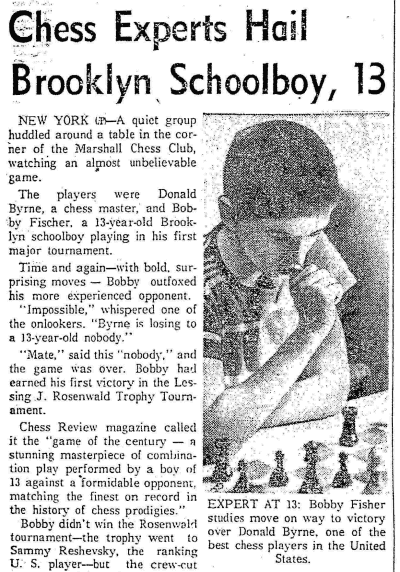
.

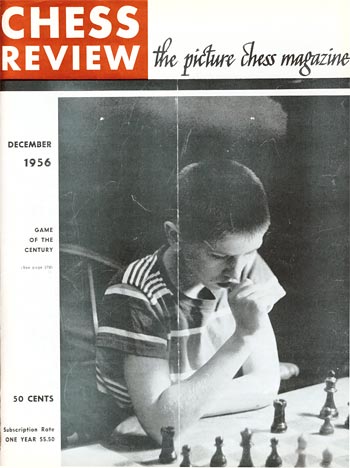

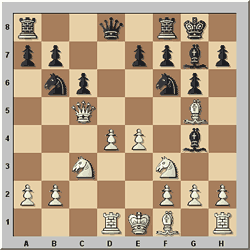
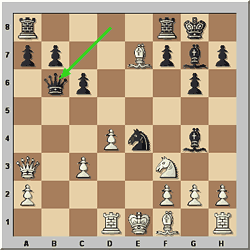
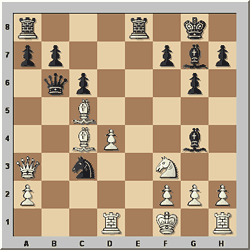
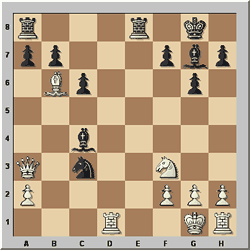
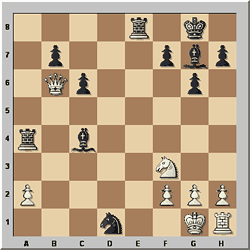
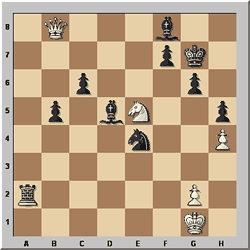
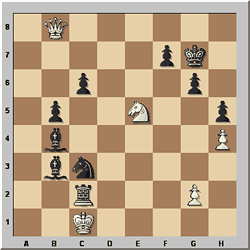







Sem comentários:
Enviar um comentário